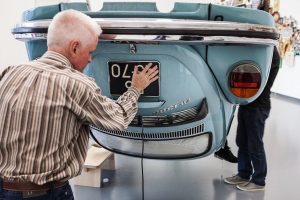Museums should be places where everyone feels welcome, argues art editor and curator-in-training Roxy Jongewaard. An argument for public as well as free museums: "A museum for everyone who can pay 17.50 entrance fee is not a museum for everyone."
In the coming year, I get to live out a personal dream: to work as a curator in a major Dutch museum. Finally, I get to participate in the dream of many a museum professional: to create a museum where everyone feels at home and where everyone's voice is heard. But that requires money, and there is hardly any.
The much-needed state aid is minimal and is provided only under two paradoxical conditions. On the one hand, a museum must be socially relevant and accessible to all; on the other hand, a museum must be able to generate a large part of its income itself. If the government really wanted museums to be places for everyone, it would remove the latter condition from its regulations.
Democratise to survive

There seems to be only a very select regular audience left for museums: the elderly and the leftist elite. Museums need to increase this audience base if they want to secure public support. They do this first of all by creating blockbuster exhibitions and promoting their museum to tourists. This does indeed generate high visitor numbers, but these are not figures that can be counted on. After all, these are visitors who are not likely to return.
So a museum needs to build a broad base of regular or at least returning visitors. They must also be able to show that they still count in this society. This has led museum professionals to harness the dream of the 'museum for all' to keep their heads above water. A trend towards democratising the museum emerged, with as many target groups as possible to be addressed.
Gin tonics and toddler tours
The democratisation of the museum was accelerated, and especially with the short-term goal of being hip and crowded. As a result, only cursory consideration is given to what exactly this concept means. In most cases, it is understood as the need to appeal to groups that would not normally come to the museum.
The Van Gogh Museum holds jam sessions and pours gin tonics to attract the yup. Museum Boijmans van Beuningen holds toddler tours, Van Abbemuseum has special tours for the mentally disabled and Stedelijk Museum Amsterdam employs a sign language interpreter guide.
While this will give an increase in visitor numbers, this too cannot be counted on. After all, visitors should not just be enticed by an extra that appeals to them. He will see his gin-tonic and themed tour as something nice for once, but will not be inclined to come back regularly to explore the museum on his own. Nor will it realise the dream of an entirely democratic museum: after all, the extras do not change the content of the museum or the dominant voice of the curator.
The all-inclusive museum
Some museums, such as the Van Abbemuseum or the Museum of World Cultures, take a more thorough approach. They really want to be a museum where objects are displayed regardless of the origin, education, or gender of the maker. They want to show not only high culture, but also the countercultures. The exhibitions and events are curated not only by the permanent curators, but also by guests: Dutch celebrities, artists or youth initiatives. Thus, the storyteller's voice, normally in the hands of the curator, is also democratised.
It is an all-inclusive museum: a place where no one is excluded. This aspiration shows guts and progressiveness. However, it is insanely difficult to bring to fruition. After all, such a museum walks the dangerous line between diversity and having no focus. Especially when there is not enough money to carry it out in its entirety, when blockbuster exhibitions and classic museum exhibits have to be shown anyway just to ensure subsidy, the concept may (partially) fail.
In Britain, city museums are already free
A place to laugh without fear
When is a museum for everyone? In my opinion, there doesn't necessarily have to be art that should appeal to everyone's demographic. You don't necessarily have to get an extra that appeals to you. You don't always need special curators who stand for different demographic groups. A museum belongs to everyone when no one feels like they shouldn't or can't go there.
A museum belongs to everyone when no one feels they have to behave a certain way. It is a place where you can laugh out loud, without feeling ashamed of it. A place where you can go inside to get warm. A place where children can run through the corridors.

Free access
The solution seems simple yet impracticable to me. If you really want to make a museum that is for everyone, you should make it a completely public building. No ticket sales, no control at the door. The door opens and you're in. Want to stay in for just five minutes? You can, you won't spend 17.50 on admission. Not sure if you like the art hanging inside? Who cares, it won't cost you anything anyway. Afraid you won't be able to make yourself understood properly? You don't have to talk to anyone.
Removing ticket sales and door control is equivalent to removing a huge psychological barrier. It shows that a museum is there for everyone, regardless of their monetary status, their origins, their level of education, their age, even their level of interest. Everyone is welcome. When this barrier is removed, it will be much easier for museum professionals to give substance to the idea of a democratic museum.
If our government really wants museums to be at the centre of society and visited by all the participants of this society, it cannot keep the subsidy on museums so low and put so many restrictions on them. A museum for everyone who can pay 17.50 entrance fee is not a museum for everyone. But when that concern is removed, both visitors and museum professionals will have the breathing space needed to work towards the dream.
